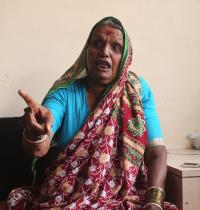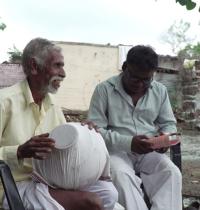Keshav Waghmare
Project Period: One year
This Foundation Project implemented by IFA will create Influential Shahirs: Narratives from Marathwada, an audio-visual documentation that is based on the lives and work of four women and four men shahirs – poet performers - from the Marathwada region in Maharashtra. This is a collaboration with the People’s Archive of Rural India - PARI. PARI is both a living journal and an online archive that records and brings to national focus the labour, livelihoods, languages, arts, crafts, histories and cultures of rural India. It makes visible the millions of stories that would otherwise remain largely unseen in mainstream media. Keshav Waghmare is the Principal Investigator for this project.
Keshav Waghmare is a writer and executive editor of Anvikshan, a quarterly magazine in Marathi. As he has been actively involved in the Dalit Adivasi Adhikar Andolan (DAAA) since 2012 and has been documenting the Marathwada communities for several years now, he is best placed to be the Principal Investigator of this Foundation project of IFA.
Maharashtra’s tradition of shahiri is several centuries old, but it was only in the last decades of the eighteenth century that it was transformed into a musical weapon against the caste system. Following in that tradition, in 1920, Ambedkari Jalsa was formed by Bhimrao Kardak, and the foundation of the Jalsa was laid by Dalit performer-poets such as K K Salve, Damodar Ahire and other popular shahirs who spread Dr Ambedkar’s teachings in the oral form, accompanied by songs. They borrowed elements from tamasha - an art form of entertainment in the rural areas, that was later improvised to create the Satyashodhak Jalsa in Shahu Maharaj’s Kolhapur, to propagate the social reformer, Jyotirao Phule’s ideals - and inserted Ambedkar’s thoughts into it. Later still, at the time of the Namantar Andolan (1972 – 95), with the mobilisation of Dalits in Marathwada and the strengthening of the Dalit movement, shahirs like Atmaram Salve, Gangadhar Pole and others made immense contributions to it. Their efforts led to the birth of a new consciousness, and they were able to captivate the minds of the masses through their songs. They saw shahiris - a combination of music and ideology - as an educative tool that would enable people to understand the complexities of oppression in a more simplified manner in their own language. Most importantly, the music of Ambedkari Jalsa went on to break the notion of music as entertainment and introduced to people the revolutionary potential of music and its creative ability to destroy the hegemonic imagination constructed in popular culture by the dominant caste-class society. These songs presented a vision of a casteless society.*
Since the 1990s however, with the country’s liberalisation, the form and content of the songs have undergone change. Although they remain alive in the ‘collective consciousness’ of the people, there is almost no documentation of the shahirs, and several of their songs remain undocumented. There is therefore a historical necessity to archive the lives of these poet-performers, document their songs and review their work and contributions in the context of the movement. The project, Influential Shahirs: Narratives from Marathwada, will archive the work of eight shahirs – four men and four women - and their role in the promotion and sustenance of a long socio-political movement.
The eight shahirs who will be interviewed for the project and whose work will be documented have been identified. They are: Atmaram Salve, Manisha Shinde and Meera Umap from Beed district; Rahul Anvikar, Meghanand Jadhav and Panchshila Bhalerao from Aurangabad district; Gangadhar Paul from Parbhani district and Kadubai Kharat from Jalna district. As Atmaram Salve is no longer alive, Keshav will refer to the work that is available and speak to other shahirs about his influence on the movement. Besides in-depth interviews, he will also record their performances when they sing on special occasions such as Ambedkar Jayanti and Annabhau Sathe Jayanti, as well as other programmes.
Through extensive visual, aural and textual documentation, the project will trace the historical connections of the shahirs and the legacy of political consciousness as it is passed on from one generation to the next – from before the Namantar Movement, to after it. The aim is to make accessible and visible, voices that have been completely silenced in mainstream establishment, as also to shed light on alternate histories of struggle in the country.
The outcome of the project will be eight articles and audio-visual recordings of live performances. The deliverables to IFA with the final report will be the articles, audio/video recordings and transcripts. All of these will also be uploaded on the PARI platform. While project funds from IFA will pay for some costs, PARI will fund the audio-visual recordings.
IFA will ensure that the implementation of this project happens in a timely manner and all funds expended are accounted for. IFA will also review the progress of the project at midterm and document it through an Implementation Memorandum. After the project is finished and all deliverables are submitted, IFA will put together a Final Evaluation to share with Trustees.
*Paraphrased from In the verses of Dalit shahirs, you can hear the history of India’s anti-caste movement by Yogesh Maitreya published in Scroll.
This project is part-supported by Goethe-Institut / Max Mueller Bhavan New Delhi.




